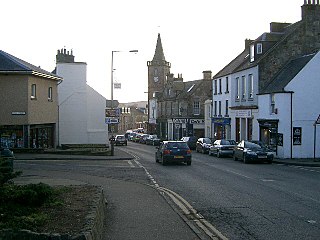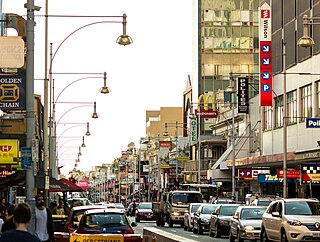History
Sanders, born in Kinross, Scotland, migrated with his wife Harriet and three children to Adelaide on the Catherine Jamieson, arriving on 30 November 1838. [1]

Kinross is a burgh in Perth and Kinross, Scotland, located around 13 miles south of Perth and around 20 miles north-west of Edinburgh. It is the traditional county town of the historic county of Kinross-shire.
He acted as agent for an absentee landlord of a River Murray property, ran Norland Farm, Lyndoch to 1864 then in 1869 acquired an interest in Canowie station, near Hallett, in 1894 restructured as Canowie Pastoral Company. He also took up a share in Warcowie station, later transferred to sons James and Robert.

Hallett is a small town in Mid North region of South Australia, situated on the Barrier Highway and former Peterborough railway line 32 kilometres (20 mi) north of Burra and 38 kilometres (24 mi) south-east of Jamestown, Hallett lies close to Goyder's Line, plotted in the nineteenth century by George Goyder, separating the land suitable for cropping from the land suitable for grazing. At the 2011 census, Hallett shared a population of 235 with adjoining localities.
He was also a partner in the Hindley Street business of Miller Anderson. He built the residence "Waverly" (later "Waverley"), designed by James Macgeorge. [2] later lived in Lixmount Cottage, Bristol Street, Glenelg.

Hindley Street is located in the north-west quarter of the centre of Adelaide, the capital of South Australia. It runs between King William Street and West Terrace. The street was named after British parliamentarian and social reformist, Charles Hindley.
James Macgeorge was a Scottish-born architect in South Australia. He is remembered for erecting South Australia's first telegraph line.

Glenelg is a beach-side suburb of the South Australian capital of Adelaide. Located on the shore of Holdfast Bay in Gulf St Vincent, it has become a tourist destination due to its beach and many attractions, home to several hotels and dozens of restaurants. Glenelg also became infamous for being the site of the Beaumont children disappearance in 1966.
He died suddenly on the train trip between Glenelg and the city. He left a substantial bequest towards construction of the Unitarian Christian Church building in Wakefield Street. [3]

Wakefield Street is a main thoroughfare in the centre of the South Australian capital, Adelaide.
